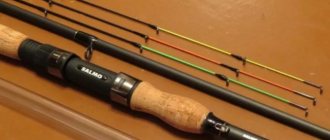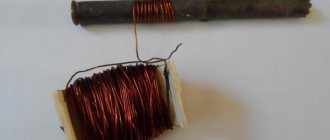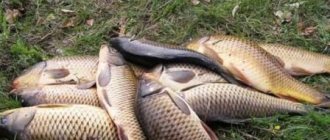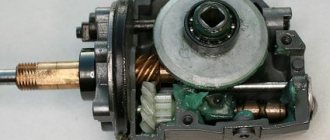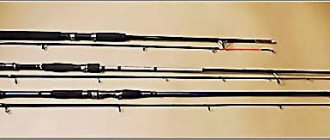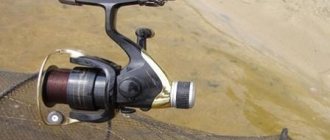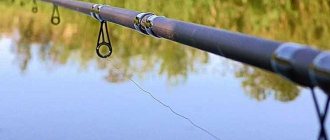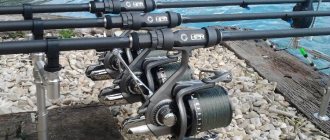What is a picker
A picker, or to be precise, a winkle picker , is a lightweight bottom fishing rod, invented in England, which can be classified as the lightest bottom fishing rod. In fact, such tackle is not much different from feeder tackle. In most cases, the rod has several interchangeable tips with different flexibility.
Since this rod is not designed for catching the largest fish, some interchangeable tips have a sensitivity of no more than 0.5 ounces. The length of the rods is usually from 2.5 to 3 meters and mostly light feed and sinkers are attached to them.
How to choose picker rods
Like any other high-tech modern fishing rod, picker tackle has its own operating parameters and characteristics that determine its purpose. Most manufacturers mark the blank of the fishing rod, thereby confirming that it is a highly specialized picking tool by placing the abbreviation Picker .
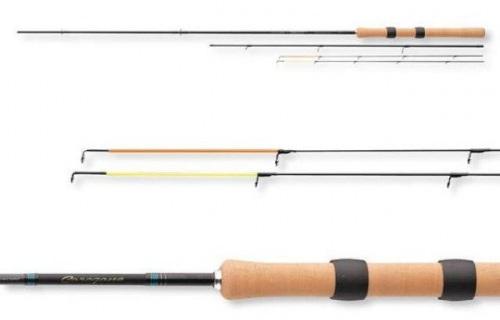
Often, a picker is a two-piece plug tackle with a short handle, which is designed to hold the tackle in one hand. The butt part of the fishing rod has a screw device for installing a reel. There are also telescopic versions of such gear on sale, but they are less accurate in the stated characteristics and are prone to the rapid formation of backlash in the joints of the knees during fishing dynamics, which is not beneficial for this type of design. Otherwise, the choice of gear is determined by the standard principles of selecting a fishing rod according to the characteristics of the form for certain fishing conditions, and also includes a visual inspection for the absence of defects and visible damage. In continuation of the article, we will delve, on a more specific basis, into the parameters of the structure of the tackle form and its working properties, the production material and the key components of the fishing rod.
Form length
Speaking about the standard lengths of a picker rod blank, it is worth staying in the range from 2.3 to 2.7 meters. There are also deviations from the standard: on the shorter side, the blank can reach up to 2.1 meters, and the longest rod in this direction is considered to be three meters. The low lengths are due to fishing strategies at short distances, up to a maximum of 40 meters, for which long-range gear is not required, but such short gear provides full convenience for casting under overhanging tree crowns. And when transported in a disassembled state, the compactness of the equipment only benefits the fisherman.
Form manufacturing material
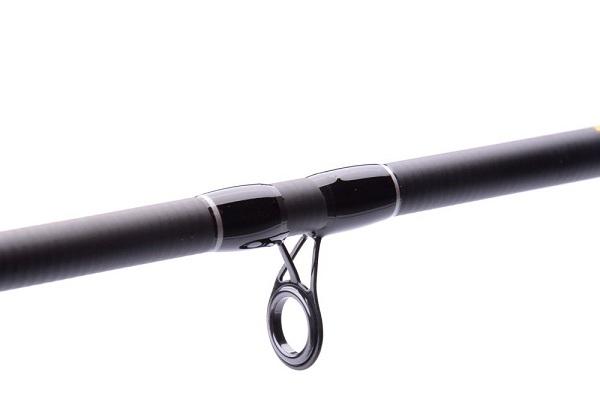
As the reader has already learned from the previous sections of the article, a fishing rod for picker fishing is distinguished by its miniature, lightness and compactness, combined with strength and ductility. All these qualities are best reflected in forms made from graphite. Graphite pickers are considered the lightest, their weight is only one hundred grams, but at the same time they are also the most expensive in value terms, which does not add to their proper popularity among fishermen. In addition, graphite requires caution when using and transporting gear, which is fragile and susceptible to any, even minor impact loads.
Composite and carbon fishing rods are considered more popular and affordable. These materials withstand the hardships of fishing and transportation much better, are easier to use and, importantly, are much cheaper than graphite options. Carbon and composite practically do not differ in their performance properties, but at the price level, composite materials are cheaper, which became the main catalyst for the rise in popularity of pickers made of composite compositions. When considering the handle of the tackle, preference should be given to cork options, and when paying attention to the fastening element for the reel, advantages are given to structures made of light metal alloys.
Build
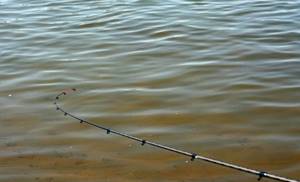
Fishing with a picker is provided by all three possible options for constructing gear. Depending on the fishing conditions, slow, medium and fast action, as well as their intermediate values, are used. Fishing parameters include weather conditions, fish activity and size. A comparison of these parameters determines the choice of system. For ease of use of picker tackle, the vast majority of manufacturers supply the rod base with interchangeable parts that differ in their rigidity parameters, which contributes to unification, or rather, adaptation of the same rod for each new and at the same time unique fishing trip.
Rod test
For a picker rod, test values are a fundamental factor. After all, the delicacy and sensitivity of equipment and accessories is higher, the smaller the test limit is included in the range. Within wide limits, the picker test mode ranges from 10 to 50 grams, but in practice, manufacturers make the ranges an order of magnitude lower, putting them within a maximum of 20 grams.
Important! Small test values require the fisherman to correctly set up the casting technique, since even the slightest inaccuracies in calculating its strength, and even more so, carelessness expressed in the tangles of the quiver-type fishing line of the tackle, lead to a break in the tip of the rod.
An important point is scrupulous control of the weight of the equipment, feeder, sinker, connecting elements of installations and nozzles. Any slight overload can cause damage to the sensitive form. Especially often, such mistakes occur among fishermen due to incorrect determination of the weight of the installation with a filled feeder, which greatly overloads the tackle, if, for example, the moisture content of the bait is not taken into account, which makes the mixture much heavier. In addition to the quiver tip breaking, which occurs in the worst case of equipment failure, overloading the rod according to the test parameter threatens a noticeable decrease in the sensitivity of the tackle and seriously reduces the degree of accuracy of feeding the equipment to the fishing point.
Quivertypes

Equipping the gear with replaceable quivertypes significantly affects the comfort of fishing and the budgetary component of its support. Manufacturers can include in the picker kit an additional three to seven quivertype options, differing from each other in structure and material of their manufacture. Fishing becomes more efficient and convenient, because a wide range provides advantages, regardless of weather conditions and fish activity.
Important! In calm weather, the most sensitive endings are installed; with increased wind and waves, they are changed to more rigid options.
The same applies to the activity of the fish: with weak and indistinct bites, setting a more sensitive quiver tip simplifies tracking the moment of hooking the trophy, and with frequent convincing bites, the hard tip allows you to catch fish at a high speed pace with a reliable hook. As a rule, the standard budget picker kit includes three quivertypes, the rigidity of which is determined based on their color or marking. The red mark indicates the stiffest tip. Green color shows the softest quivertype. Yellow color belongs to the middle scale. In one set of tackle, quivertips can be made of different materials, for example, in a carbon version of a fishing rod, the tip can be made of fiberglass, carbon or fiberglass itself, which, in principle, has absolutely no effect on the overall performance of the rod as a whole.
Application area
Picker is used for dynamic fishing of roach, crucian carp, and bream. The gear is ideal for fishing in bodies of water with a small current. Such a rod, equipped with a small sinker, allows you to accurately cast tackle over short distances into hard-to-reach places where casting with a feeder would be problematic. Also, thanks to the special structure of the rod, the chance of the tackle falling off and breaking is reduced.
Among the advantages of this gear one can also highlight:
- a light sinker practically does not scare the fish, which explains the more confident bites on this type of tackle;
- It is much easier to fish with this gear due to its lightness;
- Fish feeding occurs separately.
Advantages and disadvantages
Now let's talk about the most important thing - the advantages and disadvantages. Each rod has both its pros and cons.
Therefore, in order to choose the best assortment for successful fishing, you need to understand what the advantages and disadvantages are.
pros
The advantages include:
- A light sinker that does not scare away fish or bites. Even despite the fact that fishing will be carried out at shallow depths.
- Lightweight and easy to use. That is, much less physical effort will be spent. This is also a very important fact.
- Another important advantage is that complementary feeding must be done using separate means. That is, you first need to feed the feeder using a weight, and then connect and add or change the sinker. You can choose any method for yourself.
Minuses
Disadvantages include:
- In bad weather conditions you will not be able to use this rod.
- This method is not suitable for fishing at a great distance from the shore of a reservoir.
- Another disadvantage is that it is very difficult to catch large fish.
Picker tackle selection
There are several points that should be carefully considered when choosing picker tackle:
- all pickers have a main elbow and a replaceable top;
- You don’t need to pay much attention to the fishing reel; any fast reel that fits the size will do.
Pickers, like feeders, have several classes:
- Lightweight, loads up to 40 grams can be thrown. Mainly used in small bodies of water and medium distances;
- medium, it is possible to throw a load from 40 to 80 grams. Used on medium-sized reservoirs and rivers with small currents, cast no further than 50 meters;
- heavy, throws a load from 80 to 120 grams. Used in bodies of water with strong currents. Casting up to 100 meters.
There are also intermediate classes: light-medium and medium-heavy.
When choosing a picker rod, the sensitivity of the tips plays an important role:
- soft, for ponds with standing water;
- medium, for a current of medium strength;
- tough, for fishing in high currents.
The tip that bends the most is soft, and vice versa, the one that bends poorly is hard.
The length of the rod should be directly proportional to the casting distance, since the length directly determines how far the tackle can be cast.
Based on all of the above, we can conclude that when choosing a picker rod, you need to know in advance which bodies of water you plan to fish on. It is also worth paying attention to several details, for example, the material from which the fishing rod is made. It can be fiberglass, composite or carbon. The highest quality fishing rods are made of carbon, but they are also superior in cost.
Picker equipment
Correctly selected equipment provides half the success of fishing. In fact, even if the fish is small in size, it is still shy and then it is very difficult to get it.
The sensitivity of the tackle itself and the effectiveness of the bite are influenced by the rod. Let's take a closer look at which equipment is best to choose.
Symmetrical loop
This equipment is of the figured type, just like the asymmetrical loop. At first glance, these loops may seem very complex.
In order to dispel this doubt, you need to tie a few loops and then you will be convinced that everything is quite simple and easy.
The symmetrical loop has a double line with a loop, on one of which the feeder will float directly.
The fishing line also contains leashes and hooks. A symmetrical loop is not as sensitive to bite as an asymmetrical one.
This type of equipment can be used in fishing without using feeders with a speaker or a sinker, as well as with a feeder.
This method of rigging is very good in calm water. In a fast current, many empty bites are possible.

Asymmetrical loop
The asymmetrical loop looks like a separate tool. This loop is knitted using monofilament fishing line. Such a loop, as a rule, does not twist, as happens with other loops.
The feeder that you plan to use during fishing should move to the lowest point along the loop. Accordingly, the fish begins to take the bait you use and begins to move.
The fish will not feel any resistance as it moves.
The main idea of an asymmetrical loop is that the fish bites and hooks itself. As a result, no difficulties arise, especially for those who do not yet have experience in fishing.
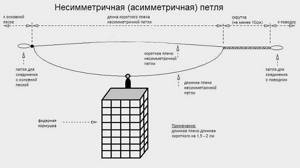
Anti-twist tube
As has been noted more than once, a very important problem is tangling and various overlaps. Why are equipment such as an anti-twist tube used? It is this that will help you avoid such problems when fishing while being in the current.
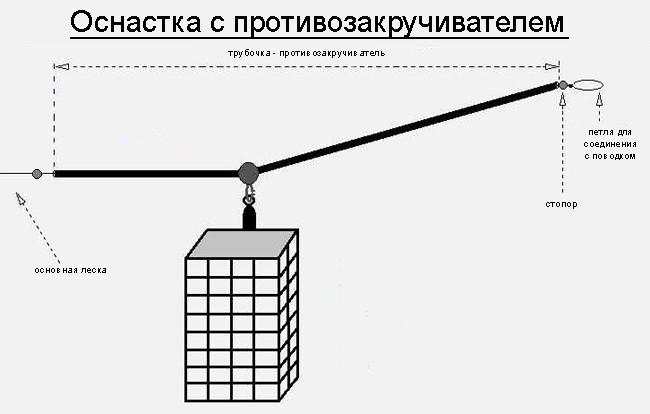
Method
With the help of such equipment as the bait method, the fish will be more effective. When using this method, open feeders are used. In such feeders the bait, which is dense in consistency, is held very reliably and confidently.
The hook and bait in an open, existing feeder should be fixed with a bait layer. This will certainly increase the chances of a bite.

Inline
Inline is a kind of sliding option. Inline most often use this type of feeder as a method or flat. With the sliding method, such a feeder is installed as a mesh of the most common and simple model.
Inline allows you to fish for very rare species of fish. That is, using this method, you can count on the fact that the catch will consist of fish such as carp or crucian carp.
Is it possible? that you can catch bream and even silver carp. Inline is used most often on reservoirs that are without current.
Of course, this does not mean that you cannot use inline on reservoirs where there is an active current.
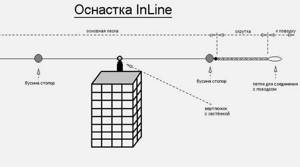
Helicopter
This equipment is also very effective when catching fish such as carp, bream, silver bream and other types of fish. In fact, a helicopter is the best for fishing on currents.
How to catch fish using such equipment as a helicopter? In fact, the technology for using such equipment is not very different from others.
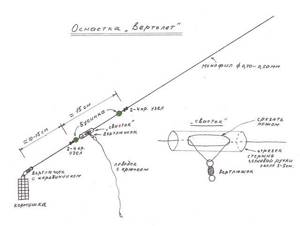
Parthenoster
Now let's talk about another well-known rig, the Gardner loop. This loop is the simplest.
In order to tie such a loop you need:
- Tie a small loop at the end of the fishing line.
- This loop will be used for leashes and hooks.
- Next, you will need to make another second loop at a distance of approximately 12 cm. It will be intended for a feeder.
It’s up to you to choose which loop to knit, small and large. It all depends on which mounting method you choose.
After the entire procedure has been completed, you need to attach the feeder and install a leash with hooks. Now you can start fishing.
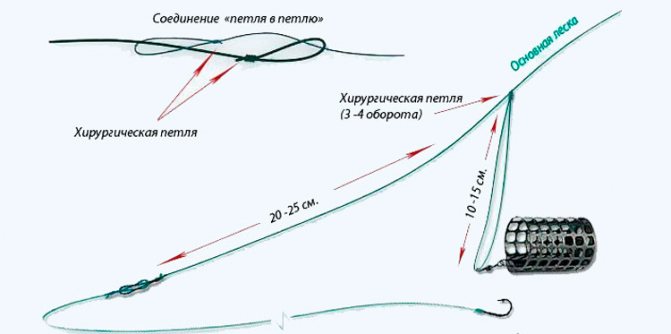
Popular rod models
Among the budget fishing rod options, you should pay attention to:
Picker SPRO Boxxer II . Length 2.40 meters, made of carbon fiber, has a rigid structure. Allows you to hang loads from 10 to 25 grams. The cost is about 700 rubles.

Picker Kaida Contact 2.4. Length 2.40 meters, test up to 30 grams. Made of carbon, it allows you to cast from 20 to 30 meters. The most popular model for close casting. Weight is only 147 grams. It will cost the buyer 1200 rubles.
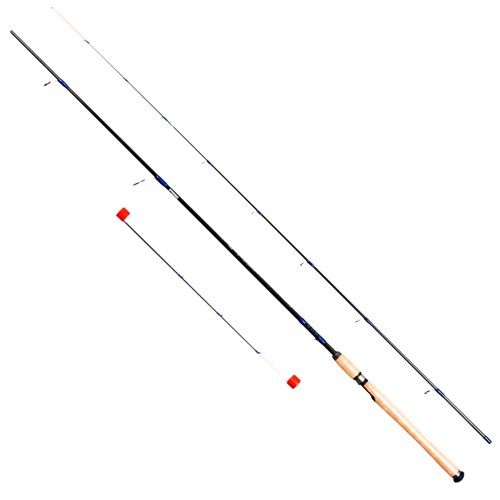
Picker Kaida Contact 2.7 . Length 2.70 meters, test up to 30 grams. Made of carbon, weight 168 grams. Price 1300 rubles.

Average price for picker.
Abu Garcia Devil rod . Length 2.40 meters, made of graphite and composite, test up to 40 grams. It has great strength and low weight (132 grams). The handles are made of cork and mahogany, which prevents the rod from slipping in your hands. Price 2000 rubles.
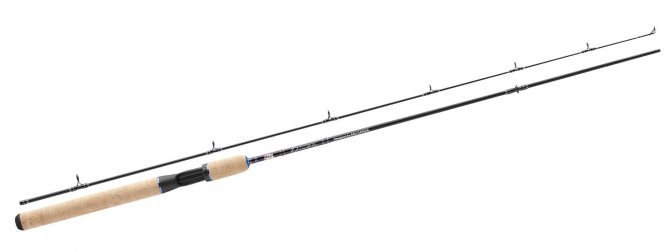
rod . Length 3 meters, test 80-120 grams. Made of carbon. It has a flexible top and is durable. Weight 142 grams. Price 1900 rubles.
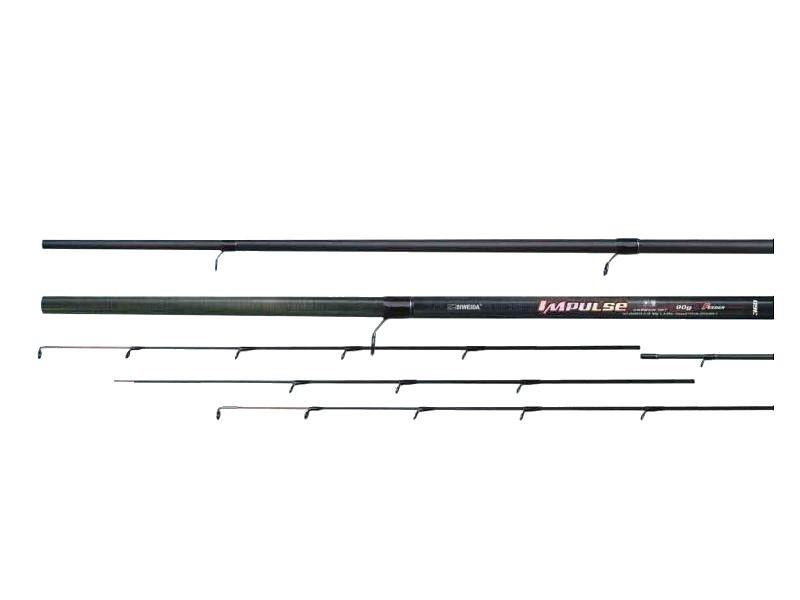
Daiwa Sweepfire rod . Length 3 meters, test 112 grams. Weight 146 grams, the rod is made of carbon. It will cost the buyer 2500 rubles.
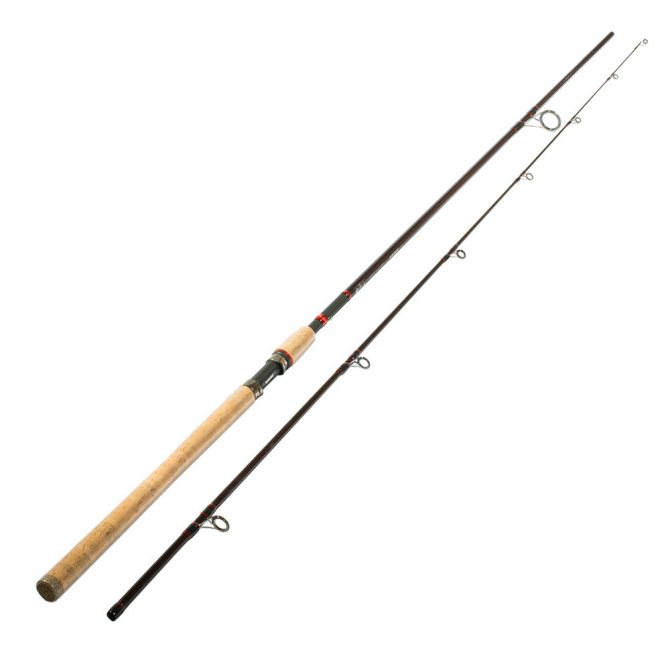
Shimano Aeronos . Weighs 140 grams, length 2.1 meters, has 7 rings and 2 sections. Cork wood handle. The rod is made of carbon. Price 2500 rubles.

Dear models.
Kaida Fortexa Gold Series rod . It has a length of 3.9 meters, test 20-80 grams. Weight 250 grams, comes with 2 covers and 3 rod tips. The knee is protected from water penetration. Silicon carbide rings. Price 5500 rubles.
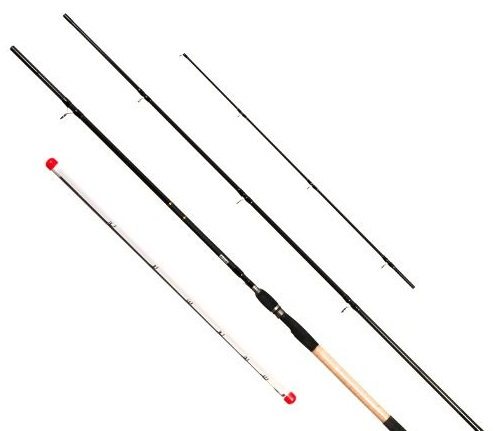
Drennan Ultralight Bomb rod . Length 3 meters. Made of carbon fiber, balsa wood handle. Test 20-80 grams. The set includes rings, 3 interchangeable tops, 2 covers, one of them is velvet. Price 6500 rubles.

Mikado Subame Piker. Test up to 40 grams. Length 3 meters. The rod is made of carbon fiber and well balanced. As you can see, prices for pickerel range from 600 to 6,500 rubles and it all depends on the fisherman’s budget.
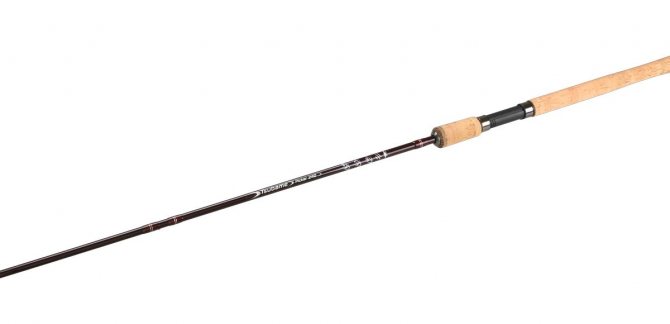
The best feeder rods
Kaida NeoXoen 3.9/60-120 (136-390)
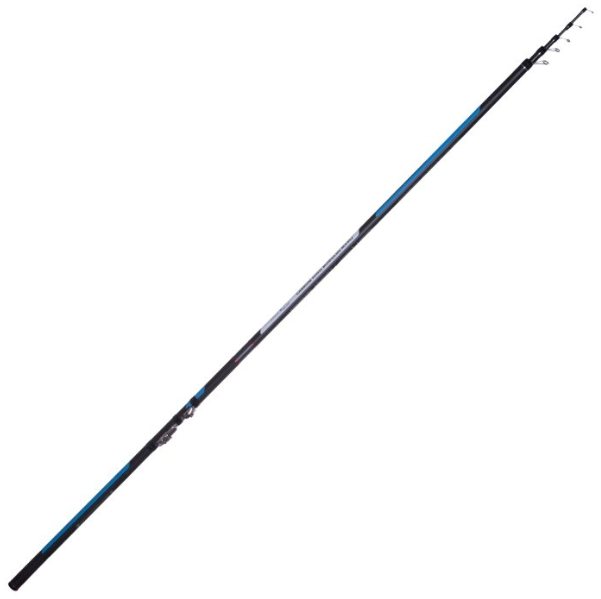
The Kaida company has proven itself well in the domestic market, offering high-quality budget gear. The NeoXoen feeder is made of carbon fiber, which makes it light, sensitive and at the same time elastic. It belongs to the extra heavy class, allows you to cast equipment weighing over 120 grams and fish in reservoirs with the strongest currents. The weight of the rod itself is 295 grams, the length when unfolded is 3.9 m, for transportation the rod folds down to 1.2 m. The rod is intended for hunting carp, bream, crucian carp and roach. The kit includes 3 tests with different weight ranges.
Advantages:
- carbon material;
- 14 SIC rings;
- excellent castability over long distances;
- comfortable handle.
Disadvantages: none identified.
MIKADO GOLDEN LION FEEDER 360 (WA-600 360)
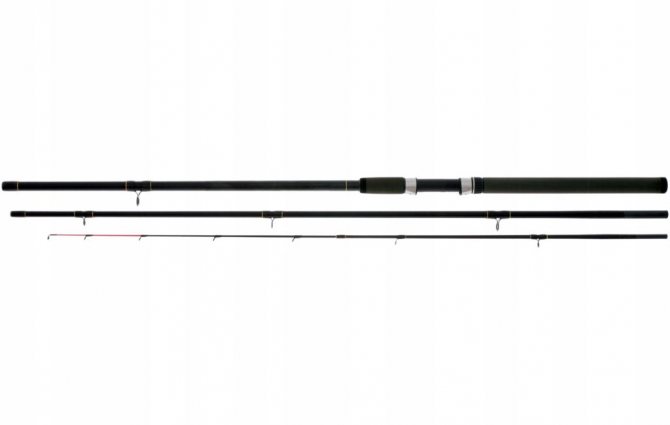
This is an inexpensive, versatile fishing rod for close to medium range fishing. A high-modulus carbon blank allows you to hook medium-sized fish, while the action of the rod is medium-fast. SiC rings with three-point reinforcement are designed for braided cords and shock leaders, and the holder is able to securely hold a spinning reel. When assembled, the rod takes up 1.27 meters, and for ease of transportation it comes with a fabric cover. Also included with the feeder are 3 whips.
Advantages:
- versatility;
- case included.
Flaws:
- the “whip to butt” joint is not very reliable.
Black Hole Hyper Feeder 390/120

This feeder is produced by a Korean manufacturer, which is loved in fishing for its budget and at the same time high-quality gear. Black Hole belongs to a particularly heavy class, allowing casting at a distance of up to 70 meters without tangling or overlapping. The strength of the rod is designed for baits weighing over 100 grams, and reinforced silicon carbide guides allow you to use any type of fishing line and braided cords. The rod has good strength. At the same time, the whip does not vibrate during the wind, maintaining a reliable fixation. This option may well be chosen by beginners who want to try feeder fishing. The set includes 4 interchangeable quivertypes.
Advantages:
- carbon fiber;
- reinforced rings.
Flaws:
- not the most convenient rod for shallow water.
DAIWA NINJA X FEEDER (11605-360)
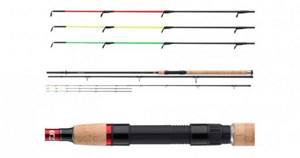
Another Extra Heavy class feeder, this time from the Japanese company Daiwa Seiko, which weighs 270 grams with a length of 3.6 meters. The power reserve allows you to use feeders weighing up to 120 grams and catch large fish. The increased size of the rings is designed for the use of shock leaders, and the high elasticity of carbon fiber makes it possible to almost completely eliminate vibrations when casting. The kit comes with 2 carbon fiber and 1 fiberglass quivertips, as well as a case.
Advantages:
- high casting range;
- the ability to use shock leader;
- light weight for carbon.
Flaws:
- The cork handle requires careful care.
VOLZHANKA Volzhanka 3.6 m up to 90 g (041-0001)

The domestic spinner is one of the popular feeders due to its good characteristics, which are inexpensive. A mixture of IM8 and IM7 graphites allows the use of test weighing up to 90 grams. The fast type of rod is suitable for inexperienced fishermen due to its high sensitivity, although this requires sacrificing casting range. The EVA and cork handle is comfortable to grip and easy to clean. The weight of the rod is 302 grams with a length of 3.6 m. However, when folded, the rod becomes 1.3 m long, allowing you to easily carry it in its original case.
Advantages:
- price;
- comfortable handle;
- case included.
Flaws:
- harsh tips;
- weak retention of the coil by the holder.
Salmo Sniper FEEDER 90 3.60 (4013-360)

Another universal feeder from the popular Chinese company Salmo is suitable for both new and advanced fishermen. The weight of the product is only 365 grams. A medium-fast action rod made of high modulus carbon fiber IM7 is suitable for ponds and lakes without significant current. The spinner rings are reinforced with a SiC carbide-silicate insert; high sensitivity allows you to easily detect a bite.
When folded, the fishing rod is 1.3 meters long. The equipment set includes 3 fiberglass tips of different hardness.
Advantages:
- price;
- good response;
- reinforced rings.
Flaws:
- no transport case.
SIWEIDA BASIC 2439061
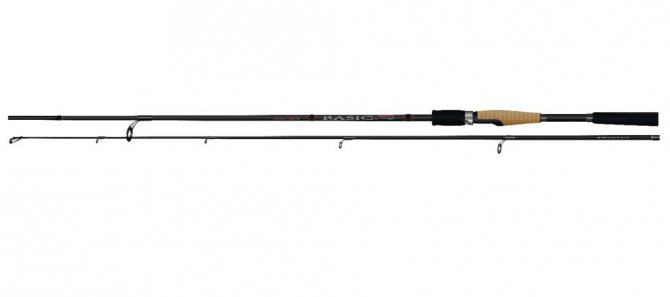
For those who are just starting to feed, the Chinese model Siweida will be a good choice. The composite construction of fiberglass and carbon allows you to buy a durable feeder at a budget price, which is designed for both fresh water bodies with fast currents and standing water. The carbide-silicate rings have a large diameter and allow the use of a shock leader. The blanks are hard and the sensitivity is above average. Weight is 390 grams, so this feeder cannot be called light. When folded, its length is 1.17 m, while when unfolded it is 3.3 meters long.
Advantages:
- composite strength;
- large ring diameter.
Flaws:
- short casting range;
- whips falling out when casting;
- above average weight.
Feeder Concept Distance 70 3.60 (FCDI070-360)
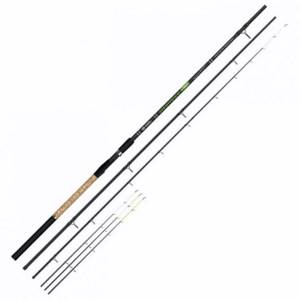
Another feeder from the Chinese manufacturer Salmo is notable for its use in sports competitions between feeder fishermen. This model is designed for ultra-long casts up to 100 meters. In addition, the medium-fast action T36 carbon fiber blank allows you to maintain accuracy and long casting even in windy conditions. The permissible weight of the bait for the Feeder Concept Distance is up to 70 grams, and the kit includes three interchangeable tips. The weight of the gear is only 232 grams, making it easy to control the feeder, and the screw holder will securely fix the reel in any position.
Advantages:
- casting distance;
- reliability;
- screw spool holder.
Flaws:
- limited weight of the tester to 70 g.
SHIMANO ALIVIO CX LIGHT FEEDER (ALCXLFDR)
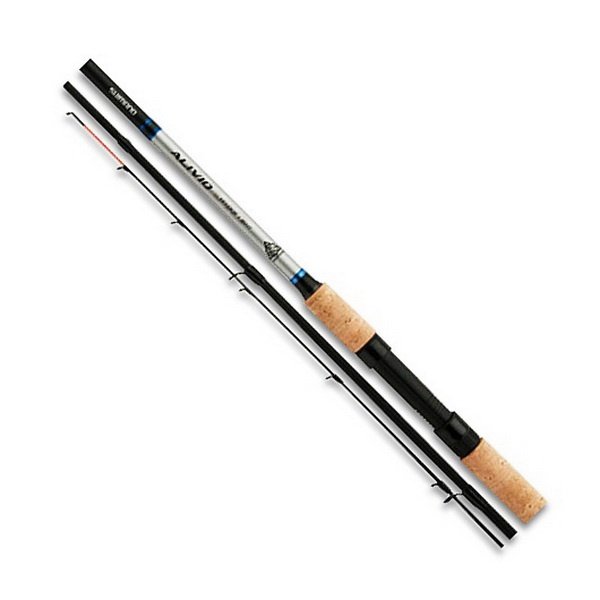
This feeder is suitable for both beginner fishermen and advanced specialists. It is made of a composite of XT30 carbon fiber and Geofibre organic fiber and has increased strength, which allows you to hunt especially large fish such as carp, grass carp or even catfish. The maximum test is 70 grams. The main feature of Shimano Alivio is the ability to change the length of the rod. The standard size of the unfolded rod is 3.35 meters, in the reduced version it is 2.74 meters. At the same time, the transport length of the filler is only 1.15 m and its weight is 221 grams. The rings are made of lightweight stainless steel, and their special design prevents tangling and tangling of the cord.
Advantages:
- composite material;
- possibility to choose the size.
Flaws:
- The Shimano reel may not have enough power for the heavy feed class.
ZEMEX Hi-Pro Feeder (HPF-011-060)
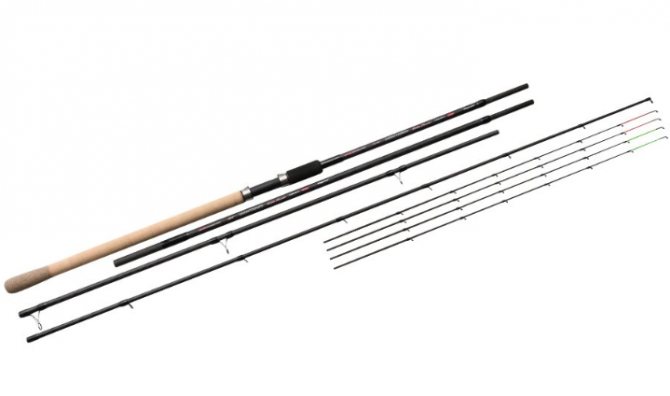
Zemex Hi-Pro is suitable for both amateur and professional fishermen. It is designed for fishing close to and at an average distance from the shore, with a feeder weighing up to 60 grams. The relatively flexible blank and anti-twist guides allow you to use thin line without the risk of it breaking when casting or jerking a fish. Any fisherman can handle the rod’s light weight of 178 grams. The neoprene handle is resistant to external factors and does not require special care. When folded, the length of the rod is 1.4 meters. The set includes a raincoat fabric cover and 3 types of tops.
Advantages:
- a light weight;
- neoprene handle material.
Flaws:
- the flexibility of the form muffles signals;
- braided cord and shock leader are not used.
This concludes our selection of popular rods for bottom fishing and we hope that this short review will help you choose the best option.
Picker coil selection
Recently, many reel manufacturers have begun to produce their products specifically for pickerel fishing. It is very important to find a balance between the reel and the picker rod. Let's look at the parameters that you should pay attention to when choosing a picker coil.
- Reel cost. The reliability of the coil and the material from which it is made directly depend on this parameter. The price of a normal reel ranges from 1,500 to 6,000 rubles. An inexpensive reel is suitable for a beginner fisherman.
- Gear ratio. This parameter shows how many times the reel is rotated per turn of the handle. This is the ratio of the number of turns of the reel to the number of turns of the handle. For pickerel fishing, it is recommended to purchase reels with a gear ratio from 4.6 to 5.5.
- The third parameter is the size and material from which the spool (reel rotor) is made. The spool size is written on each reel. For pickerel fishing, the best options would be 2500-4000.
- Clutch type . The friction prevents the line from breaking. There are two types of friction brakes - rear and front. Here, as it is convenient for anyone, the choice is up to the fisherman. The first one is more convenient to adjust and easier to replace the spool, the second one is more convenient to set up.
- Number of bearings. The smooth operation of the coil depends on them. In many reels their number exceeds 10. It is worth limiting yourself to a model with 5-6 bearings.
Which fishing line to choose
In this aspect, there are only 2 options to choose from: braided or monofilament line. However, even such a small choice leaves many questions. Next, we will consider the advantages and disadvantages of both types, as well as factors that may influence the choice of fishing line.
- Catching distance. When fishing at a long distance, braided line will be more useful, since when hooking, it will be enough to take the fishing rod and move it a maximum of half a meter.
- The power of the current. In case of strong currents, again, braided line wins, since it has much higher resistance to water pressure.
- Fish size. The larger the fish, the more convenient the monofilament line will be. However, picker fishing is not designed for particularly large specimens, so braided line is again best here.
- Air temperature. At low temperatures from -10 degrees Celsius, monofilament is ideal, since ice will not freeze on it.
- Biting intensity. When fishing for wary fish, you should use braid, as this is a very sensitive line that will be able to catch the slightest bite.
- Wind power . In strong crosswinds, it would be better to use braided fishing line.
- Price. The cost of braid is many times higher than monofilament, but it lasts much longer (4 seasons instead of 2).
So, having considered all the factors influencing the choice of fishing line, we can conclude that in this case there is no clear choice and it is necessary to act according to the situation.
Picker rod rig
Fishing with a pickerel fishing rod involves the use of light weight and feed; such characteristics depend on frequent casts and light testing of fishing rods, as well as the additional possibility of feeding with a slingshot during the biting process.
If there is current or rainy weather on the pond, then use open cylindrical feeders. Bait in small lakes and ponds is made using flats and banjons; flats and banjons should not be too heavy so as not to fall into the grassy thickets near the shoreline when casting.
If the bottom of the reservoir is rocky, then you should choose a spoon weight, and in hard ground it is better to use olives and balls; if the bottom is with silt, then choose flat feeders. The weight is much lighter than the feeder, so when casting it will not scare away the fish and will fall to the bottom faster, as it has high flight accuracy.
If there is not a strong current and waves on the reservoir, then a ball weighing 25 grams is suitable as a load; balls are suitable for any bottom, except for a bottom with stones; on rocky bottoms it is better to use a spoon weight, it is directed to the fishing point over stones much easier than ball, but it stays on the bottom worse.
If you need to do an inline installation, then the weight must be equipped with a small-diameter loop; if the eyelet is missing, you will end up with a blind installation with a weight.
Feeders in the form of thimbles are more suitable for sport fishing, thimbles are small in size and the food is washed out of them very poorly; for large bodies of water this will not be enough, and the fish simply will not bite on such a quantity of bait.
In picker fishing, rocket rigs are not used, they will not cast more than 30 meters, and the load for bait is not used with a large weight; if necessary, you can constantly deliver bait with a slingshot.
The main bait in picker fishing is inline installation; a more sensitive method has not yet been invented, but you need to be careful with it, inline installation is easily confused when casting, so you should not make sudden movements when casting long distances.
Inline installation is carried out as follows: a carabiner and a bead are put on the fishing line and a swivel is fixed, the leash is tied to the swivel with a loop and a sinker or feeder is fixed to the carabiner.
If you spread a load along the line, the bait will be even more sensitive, the fish will almost not feel the load and you can use a short leash.
Equipment for pickerel fishing
There are several options for lightweight picker equipment, for example, sliding and blind.
- a blind can be made using a small piece of fishing line, attaching the required number of lead balls to it;
- sliding is done like this: take a lead pipe and cut the required number of small tubes, after which they are threaded into a fishing line.
As you can see, there is nothing complicated about the picker equipment. The main difficulty is to equip them depending on the situation.
Selection of optimal load and feeder
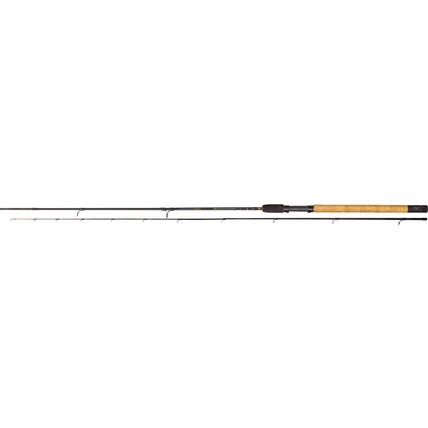
Considering that the maximum test for a picker does not exceed 50 g, the load and feeder should have a minimum weight. As with feeder equipment, you can use a sliding or “blind” load, but not heavier than 15 g. It can be attached to the main fishing line, as well as to an additionally tied section of it.
Instead of the usual solid weight, fishermen prefer to use a composite weight, both with sliding equipment and with “blind” equipment. To do this, several lead pellets are attached to a piece of fishing line 3-5 cm long and with a cross-section of 0.3 mm.
Then this structure is fixed to the main gear in the most suitable way. In this case, the equipment itself is not loaded, which means it has increased sensitivity.
Another option involves installing a load on a leash using a method of assembling pieces of a thin lead tube interspersed with fragments of a rubber tube like a nipple. This entire “chain” moves freely along a section of fishing line limited by special rubber stoppers.
The use of a feeder on picker gear is not at all necessary if it is possible to systematically feed the fishing site, however, most anglers still recommend using it. Especially if you have to fish in a place with a strong current.
When choosing a feeder, it is necessary to take into account the weight of the load being installed, the density of the bait, as well as the test indicator of the rod. In other words, the total weight of the equipment should not exceed it.
Otherwise, this threatens either a problem with casting or a breakage of the fishing rod. If the weight of the load is 10 g, the bait is 15 g, then when testing the rod at 50 g, the feeder should not weigh more than 25 g. It is better when the entire tackle assembly does not exceed 2/3 of the test value.
The shape and type of feeder are selected depending on the characteristics of the fishing site and the bottom.
- It is preferable to use plastic models when the bottom of the reservoir is covered with vegetation or has sharp changes.
- Metal feeders are best used on flat and hard bottoms.
To catch large fish, the pickerel rig should be mounted on a braided line. This will allow you to use force when fishing fish out of the water. The cord can have a diameter of 0.08-0.1 mm.
The correct picker equipment will ensure success in fishing. Its installation should be simple. The leash can be secured using a swivel clamped between two stoppers. This design will allow you to quickly change feeders.
The most unsuitable option for fastening the feeder in this case is the use of an anti-twist tube.
The feeder can be plastic or metal. Its mass should be equal to the weight of the body without end walls. The bait should be freely released from the feeder.
Here's what you need to know: Jig rigs for beginners
DIY picker
In some situations, it is easier to make such a fishing rod with your own hands, using some old spinning rod for this purpose.
The requirements for the future picker should be the following:
- high sensitivity, since the tackle will be intended for small fish;
- immediate cutting;
- a large margin of safety when pulling fish out of a reservoir.
It is recommended to make the top of the device as sensitive as possible so that it can withstand the loads of fast and strong currents. You can take an ordinary telescopic spinning rod of short length (about 2 meters), remove the tulip and upper elbow from it, select the top suitable for the picker and glue it in place of the removed elbow. The main advantage of such a picker will be its compactness and the possibility of more or less long-distance casting.
Now, with the new top, the sensitivity of bites will increase. So, the procedure will be as follows:
- Find a broken spinning rod.
- Remove the damaged part.
- Choose a suitable top (can be from another broken spinning rod).
- Cut the tube to size for the sleeve at the site of the future top.
- Apply glue to the sleeve and install it on the spinning rod.
- After the glue has dried, you should shake the fishing rod and check if it is knocking.
- Equip the picker according to the situation.
As you can see, making your own pickerel rod is not that difficult, and you can save a considerable amount of money.
The only disadvantage of such a rod is that it does not fold, since we put the top on glue.
Bait attachments
Bait is considered an important factor in obtaining a good catch. The key to good bait:
- bait composition;
- viscosity;
- ratio of components.
Many fishermen make bait according to their own recipe, using old proven ingredients such as cake, corn, millet, sunflower oil. However, the composition of bait for pickerel fishing is very different from the usual fishermen’s recipes. The requirements for picker bait are as follows:
- The bait falls apart at the bottom into small components, so almost half of the bait comes from ingredients that make it heavier.
- The bait forms a spot at the feeding site.
- The mixture must be washed in exactly the allotted time (5 to 10 minutes).
The bait for picker fishing includes 3 ingredients:
- The basis. This could be dry cereal or cake.
- Filler. Cereals, corn, boiled peas.
- Flavor enhancer. Vanilla, sugar, essential oils. Don't get carried away and add a lot of amplifiers - this can scare away the fish.
The bait should be mixed in the water in which the fishing will be carried out. After kneading, you should wait 10 minutes for the bait to soak in. Form the prepared bait into balls with a diameter of about 5 centimeters.
The bait on a pickerel can be very different, it all depends on the fish that the fisherman is hunting. It could be a worm, maggot, crumpet, bread, semolina, corn, peas. When digging for worms, you should dig for dung. They differ from the earth ones in their redder hue and live in dung heaps and pits with humus. You can buy maggots in fishing stores, or you can cook it yourself, leaving a small piece of meat in the open air.
Fishing technique
The technique of fishing with pickerel is not known to many people, so here we will try to describe as many points as possible.
- Before throwing the picker tackle, you should feed it to the fishing site. You need to throw three to five balls of bait into the water. After a few minutes you can cast the tackle. With this type of fishing, it is necessary to control the gear at all times.
- Sometimes anglers pull out the rod at regular intervals. This way the fish gets used to the casting and stops being scared.
- If the tackle is too light, you need to be prepared to hook the fish, otherwise there is a high probability of the prey falling off the hook.
- With constant uncertain bites, you should show a little patience. The fish may be “tasting” the bait.
- Before fishing, it is recommended to “feel” the bottom. A fishing rod with a large load attached to it is ideal for this. Knowing the topography of the bottom, you have a much better chance of catching more fish.
Essence of Picker
Picker has many advantages. In some conditions you simply cannot do without it.
Moreover, the list of positive qualities of the mini-feeder will increase as it is mastered. There will be practically no restrictions on its use.
The design of the picker rod allows you to fish both deep and wide of the reservoir. Even in the most difficult places, this type of gear will allow you to successfully fish if you have the proper experience.
Pickerel fishing allows the fisherman to conquer even lakes with densely overgrown water areas. Fishing can be done at almost any time of the year.
Success is achievable with proper balancing of the gear. This will prevent the line from breaking. The right equipment will allow you to catch really large specimens.
